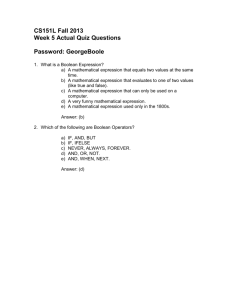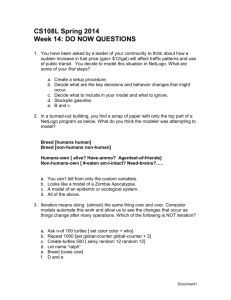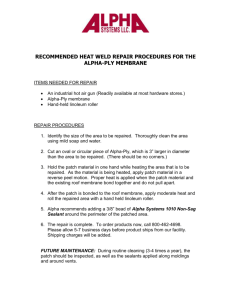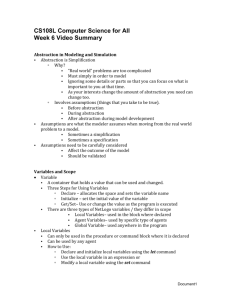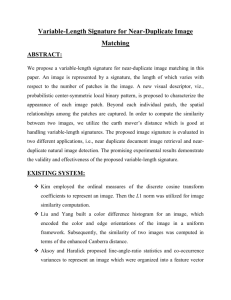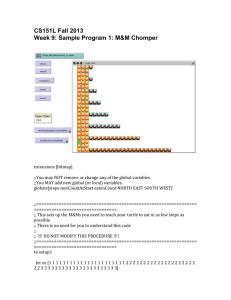NetLogo Cheat Sheet (.doc) - New Mexico Computer Science for All
advertisement
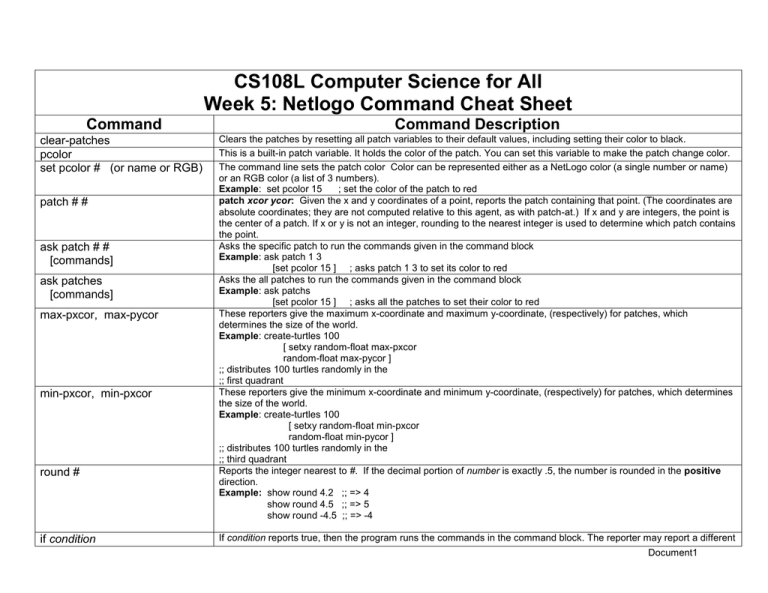
CS108L Computer Science for All Week 5: Netlogo Command Cheat Sheet Command Command Description clear-patches pcolor set pcolor # (or name or RGB) Clears the patches by resetting all patch variables to their default values, including setting their color to black. This is a built-in patch variable. It holds the color of the patch. You can set this variable to make the patch change color. The command line sets the patch color Color can be represented either as a NetLogo color (a single number or name) or an RGB color (a list of 3 numbers). Example: set pcolor 15 ; set the color of the patch to red patch xcor ycor: Given the x and y coordinates of a point, reports the patch containing that point. (The coordinates are absolute coordinates; they are not computed relative to this agent, as with patch-at.) If x and y are integers, the point is the center of a patch. If x or y is not an integer, rounding to the nearest integer is used to determine which patch contains the point. Asks the specific patch to run the commands given in the command block Example: ask patch 1 3 [set pcolor 15 ] ; asks patch 1 3 to set its color to red Asks the all patches to run the commands given in the command block Example: ask patchs [set pcolor 15 ] ; asks all the patches to set their color to red These reporters give the maximum x-coordinate and maximum y-coordinate, (respectively) for patches, which determines the size of the world. Example: create-turtles 100 [ setxy random-float max-pxcor random-float max-pycor ] ;; distributes 100 turtles randomly in the ;; first quadrant These reporters give the minimum x-coordinate and minimum y-coordinate, (respectively) for patches, which determines the size of the world. Example: create-turtles 100 [ setxy random-float min-pxcor random-float min-pycor ] ;; distributes 100 turtles randomly in the ;; third quadrant Reports the integer nearest to #. If the decimal portion of number is exactly .5, the number is rounded in the positive direction. Example: show round 4.2 ;; => 4 show round 4.5 ;; => 5 show round -4.5 ;; => -4 patch # # ask patch # # [commands] ask patches [commands] max-pxcor, max-pycor min-pxcor, min-pxcor round # if condition If condition reports true, then the program runs the commands in the command block. The reporter may report a different Document1 [commands] ifelse condition [commands1] [commands2] patch-ahead # random-pxcor, random-pycor Distancexy # # resize-world # # # # any? criteria turtles-on value for different agents, so some agents may run commands and others don't. Example: if xcor > 0[ set color blue ] ;; turtles in the right half of the world turn blue If condition is true, runs commands1. If condition is false, runs commands2. The reporter may report a different value for different agents, so some agents may run commands1 while others run commands2. Example: ask patches [ ifelse pxcor > 0 [ set pcolor blue ] [ set pcolor red ] ] ;; the left half of the world turns red and the right half turns blue Give you patch that is the given distance, #, "ahead" of this turtle, that is, along the turtle's current heading. Reports nobody if the patch does not exist because it is outside the world. Example: ask patch-ahead 1 [ set pcolor green ] ;; turns the patch 1 in front of this turtle green; note that this might be the same patch the turtle is standing on Provides a random integer ranging from min-pxcor (or -y) to max-pxcor (or -y) inclusive. Example: setxy random-pxcor random-pycor Reports the distance from this agent to the point (xcor, ycor). The distance from a patch is measured from the center of the patch. Turtles and patches use the wrapped distance (around the edges of the world) if wrapping is allowed by the topology and the wrapped distance is shorter. Example: if (distancexy 0 0) > 10 [ set color green ] ;; all turtles more than 10 units from the center of the world turn green. Changes the size of the patch grid. As a side effect, all turtles and links die, and the existing patch grid is discarded and new patches created so it should be used before you create turtles. Reports true if there are any turtles with the criteria Example: if any? turtles with [color = red] [ show "at least one turtle is red!" ] ;; prints “at least one turtle is red if there are any red turtles Reports the set of turtles that are on the given patch or patches. Example: ask turtles [ if not any? turtles-on patch-ahead 1 [ fd 1 ] ] ;; if there are no turtles on the patch ahead then move forward 1 step Document1


